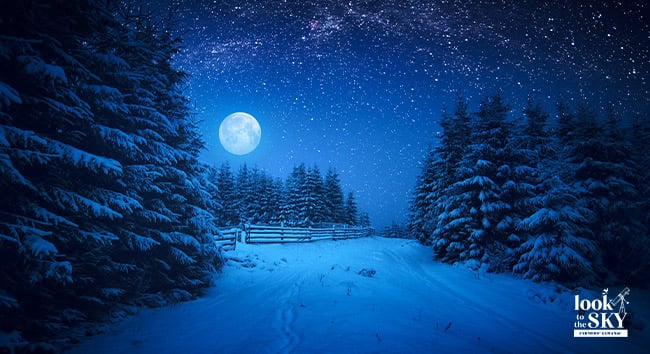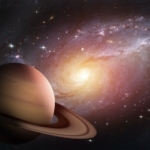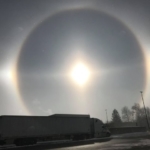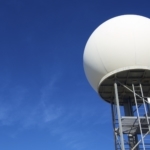The December night sky will have many celestial highlights, including the full Cold Moon, one of the best meteor showers of the year, and beautiful pairings of bright planets alongside the crescent Moon. Here is everything you need to know about the sky this month. Have questions? Ask us in the comment section below!
Share your love of stargazing with your family and friends this year! Don’t miss our growing Starry Nights Gift Guide; gifts for night sky lovers of every age and stage!
Note: All times and positions are listed in Eastern time, 40 degrees north of the equator—unless otherwise listed. If you see the term “local time,” it is true no matter where you are located (no need to add or subtract for your time zone).
Look for the telescope emoji – 🔭 – as a quick reference for when recommend using telescopes and binoculars.
Bookmark this page now (Press command+D on your keyboard) so you can easily refer to it for stargazing over the next few weeks.
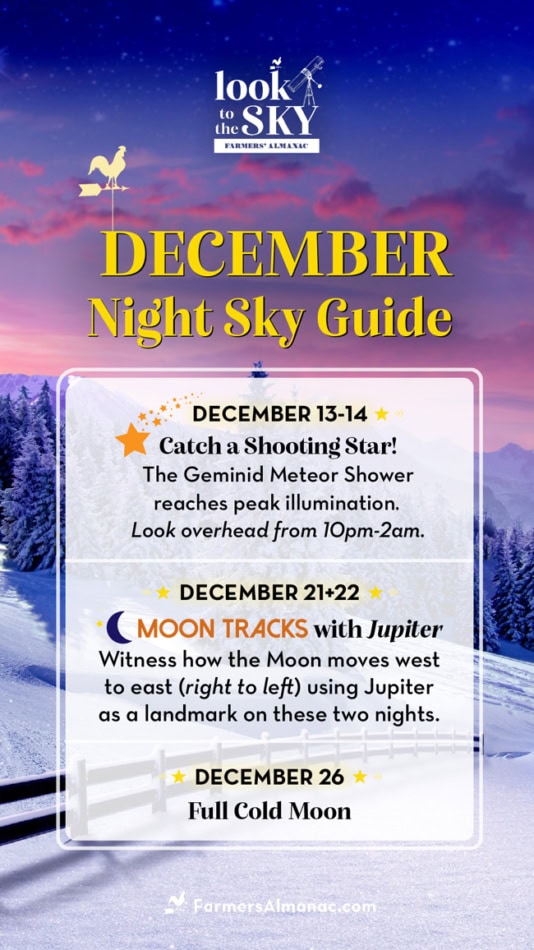
December Night Sky Guide
Venus dazzles as a morning star in the east throughout December (dimming slightly, from magnitude -4.2 at the beginning of December to -4.1 at the end). It rises three to four hours before sunup. Learn more about the visible planets.
December 4 – Mercury
Mercury reaches greatest elongation east (21 degrees from the Sun and magnitude -0.2) this evening, when it sets in the southwest approximately one hour after sunset. (Note: This is a very low apparition for viewers at mid-northern latitudes.)
From now through December 13, the planet is visible six degrees above the southwest horizon a half hour after sunset. During this period, it fades from magnitude -0.4 to +0.5 as its phase wanes from 62% to 28% lit. After that Mercury fades and drops rapidly, and it soon becomes a difficult target even for binoculars and telescopes.
RELATED: Learn more about magnitudes, degrees, and other astronomical terms.
December 5 – Last Quarter Moon
The last quarter Moon occurs at 12:49 a.m. EST.
December 9 – Venus And The Crescent Moon
Look low toward the east-southeast this morning at around 5 a.m. to catch Venus and a slender crescent Moon. (Venus will be about four degrees to the upper left of the Moon.)
December 12 – New Moon
The new Moon occurs at 6:32 p.m. EST.
At around 10:30 p.m., look overhead and you will see the brilliant golden-yellow star Capella in the constellation of Auriga, the Charioteer.
According to the most ancient legend, Auriga was a goat herder and patron of shepherds and all who tend flocks. Yet, the Greeks and Roman made him a famed trainer of horses and the inventor of the four-horse chariot. The confusion in concepts is reflected in the ancient allegorical pictures and star names.
Auriga is represented holding a whip in one hand in deference to the Charioteer story, but in the other arm next to Capella are three tiny stars, known as The Kids. The Kids star Epsilon Aurigae is a double star. The larger one dims the brighter one every 27 years, with the next eclipse scheduled in 2036. The visible component is a supergiant star, about 100 times larger than our Sun. The other (eclipsing) component is not visible.
⭐🔭 December 13-14 – Catch A Shooting Star!
Bundle up! One of the best meteor showers of the year awaits you in the December sky. The Geminid Meteor Shower a/k/a “The Gems” will reach peak activity between 10pm and 2am on December 13-14. You may see one meteor per minute streak across the sky!
The Geminids have a reputation for long, slow, graceful yellowish meteors and occasional fireballs. The Moon will be absent from the sky this year, and the frosty air is likely to be especially transparent.

Shooting stars from this shower also may be visible from December 4-12 and 15-17, but rates will be much less—approximately two meteors per hour.
Note: This is one of the coldest months of the year for stargazing, so if you plan on spending any long length of time looking for meteors, make sure to be snug in many layers from head to feet with no pinches or thin spots. An electric hot pad buttoned inside your clothing will certainly help.
RELATED: Starry, Starry Night Gift Guide
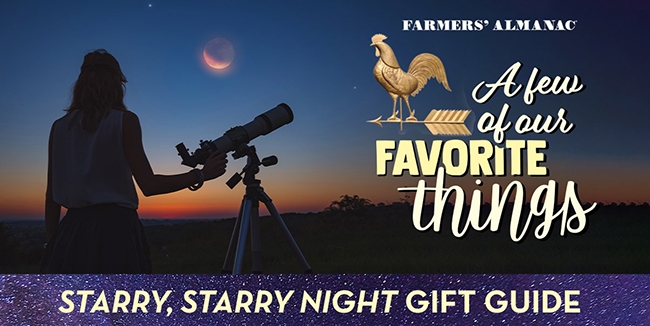
🔭 December 17 – Scope It Out: Saturn And The Moon
Look south after sunset to see Saturn hovering about three degrees above a waxing crescent Moon. Over the course of the month, Saturn will appear to move eastward relative to the stars in the constellation Aquarius. (Yet according to astrology, Saturn is in Pisces. Learn The Difference!)
RELATED: Astronomy vs. Astrology
During the month Saturn’s brightness fades a bit and in a telescope its rings collapse.
December 19 – First Quarter Moon
The first quarter Moon occurs at 1:39 p.m. EST.
December 21 – Winter Solstice
Today the Sun arrives at the winter solstice in Sagittarius at 10:27 p.m. EST. This event marks the first day of winter in the Northern Hemisphere (and summer in the Southern Hemisphere).
Also, this evening, you’ll see planet Jupiter shining brightly to the left of the waxing gibbous Moon.
⭐ December 21+22 – “Moon Tracks” With Jupiter In The December Night Sky
Did you know that the Moon moves right to left (west to east) over the course of the month? (This is the opposite direction that it appears to move on any given night.) Get a glimpse of the Moon’s motion as it orbits the Earth by using Jupiter as a landmark on these two nights! (Jupiter moves slower than the Moon, so it makes a great reference point.)
On the first night, December 21, the waxing gibbous Moon will be positioned to the right of Jupiter. The following night, December 22, the Moon will be positioned to the left.
If either of these two nights happens to be cloudy or foggy, rest assured there will be many other chances to track the Moon in the future. Stick with us!
December 22 – Mercury Aligns With The Sun
Mercury passes through inferior conjunction today and disappears in the bright glow of the Sun. At this time, Mercury travels between the Sun and the Earth (In this way Mercury’s position it is similar to how the Moon hangs between the Sun and the Earth during a new Moon phase — see December 12 above.)
December 23 – Ursid Meteor Shower
This a poor year for the two-day Ursid meteor shower, which will be at its best this morning. In 2023, this falls just three days before full Moon. Under a clear, dark sky a single observer might see 5 or 10 of these meteors per hour, emanating from near the bowl of the Little Dipper. But that bright Moonlight will likely squelch all but the brightest shower members.
⭐ December 26 – Full Cold Moon
The full Cold Moon reaches peak illumination in the December night sky at 7:33 p.m. EST. The first full Moon of the winter season is sometimes referred to as “The Long Night’s Moon,” because nights now last the longest and the full Moon, being opposite to the low winter Sun, now describes a high arc across the sky during the course of the night. Living up to its name, the Moon is in the sky for some 16 hours … rising around 4 p.m. and not setting until around 8 a.m. the following morning.
🔭 December 31 – Mercury And Venus
Up for a challenge? Look southeast approximately one half hour before sunrise to witness the planet Mercury returning to the sky as a “morning star.” Mercury will sparkle in the predawn sky along with bright planet Venus through the first month of the new year.
Psst … get your local sunrise/sunset and moonrise/moonset times at The Farmhouse today!
Join The Discussion
Which December night sky event are you looking forward to most?
We would love to hear from you.
Have questions? Leave a comment below!

Joe Rao
Joe Rao is an esteemed astronomer who writes for Space.com, Sky & Telescope, and Natural History Magazine. Mr. Rao is a regular contributor to the Farmers' Almanacand serves as an associate lecturer for the Hayden Planetarium in New York City.

